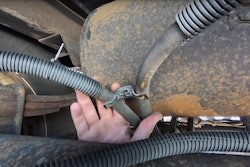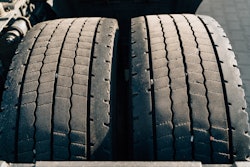
Winter is tough on shocks, making maintenance all the more important considering the critical role shocks play in truck handling and safety.
According to Monroe’s commercial vehicle division, shocks play a vital role in all three parts of the safety triangle: they help distribute weight over tires to improve handling and steering during turns; they work alongside properly maintained brakes to help stop a truck sooner under certain driving conditions by minimizing weight transfer; and shocks and tires work together to help maximize tire-to-road contact, improving truck stability.
However, when harsh winter weather sets in, shock performance can decline, leading to handling and safety concerns — that is if fleets don’t stay on their toes to ensure that shocks are in good working order.
“Breakdowns during extreme winter weather can not only be costly, but extremely dangerous,” said Larry Clark, senior vice president of product research and development at Bulldog HD. “In winter weather conditions such as snow, the truck’s weight and handling characteristics can dramatically change.
“In addition, icy roads can make driving conditions challenging – quality of roads less than ideal – and adding a greater chance of damage to suspension components, making the truck harder to control and increasing the likelihood of an accident,” Clark continued.
 Shock maintenance becomes even more critical during harsh winter months. Monroe's commercial division points out the benefits of healthy shocks above.Monroe
Shock maintenance becomes even more critical during harsh winter months. Monroe's commercial division points out the benefits of healthy shocks above.Monroe
“The simple answer is yes,” he said. “All suspension components, including tires, will be affected by cold temperature. The result will be increased harshness and higher impact loads transferred to the vehicle chassis and driver.”
Stressed shocks already near end-of-life “could be subject to failure with a change to cold temperature,” Anderson added, making it more critical he said to inspect shocks “more often for worn or damaged components.”
Of course, the best approach is to inspect shocks and correct any issues before winter comes calling. It’s also advised to keep a close eye on shocks throughout the more challenging colder months. For instance, ice and road grime can build up on suspension parts, increasing the likelihood of damage or premature failure, Clark said.
“Inspect your shocks regularly during the winter months by watching signs of oil leaks,” Clark continued. “Examine mounting weld points for cracks and breaks caused by road hazards. Always change your shocks when a tire or airbag replacement is performed on a truck. If road conditions are severe, it is best to increase awareness and adjust driving patterns to maximize and extend the life of your shocks.”
How shock performance changes in winter
Even shocks in good working order can be subject to performance problems when temperatures drop.It’s the materials used in shock construction – like oil and rubber – that can be impacted by freezing weather, which in turn impede their dampening abilities and leave both truck and driver with a rougher ride until things warm up.
“Cold temperatures can affect rubber components such as mount bushings and internal components such as piston and rod seals,” Anderson said. “The cold temperatures also will affect the shock oil viscosity. The result is the shocks will be more stiff than normal until they get back to normal operating temperatures. This may take a few miles of driving depending on road conditions and ambient temperatures for the oil.”
Rubber on the other hand doesn’t warm up as quickly as oil and “will take longer to lose some stiffness,” Anderson added.
Clark said oil type becomes more critical in colder temperatures.
“Ideally, a premium all-weather oil is preferred, tested and able to perform at -30 degrees Celsius,” he said. “All-weather oil allows greater protection and less likelihood for the oil in the shock to thicken, which reduces its dampening performance characteristics.”
An unfortunate consequence of freezing oil wiper seals can be oil blow by, or misting; when the rubber seals lose their elasticity and cannot effectively contain the oil that’s under pressure in a shock.
“The loss of oil will reduce the shock’s ability to provide optimal dampening performance,” Clark said.
Know what to shop for
Trucks subjected to harsher winters will more than likely present more shock issues than trucks operating in warmer climates. It’s not just the freezing temperatures that adversely affect performance but also the roads themselves, which Monroe points out can be more damaged from buckling and potholes that develop from the freeze-thaw cycle.“Road conditions, such as potholes and pavement impacts, can also create a force multiplier leading to a multitude of suspension, mounting points and tire damage,” Clark said. “All these issues can lead to increase driver fatigue, safety challenges, costly fixes and unwanted downtime.”
That’s where spending a little extra on shocks can help spare both truck and driver from some jarring and uncomfortable rides.
“Premium shocks have seals that are formulated with molecular properties to withstand extreme cold conditions and allow them to continue to perform their [dampening] function,” Clark said.
Also, look for reinforced double welds at the mounting eyelets which “are built to withstand the rigorous suspension jarring and impacts created by winter damaged roads,” Clark added.
Don’t go cheap and end up with a shock that’s not up for the more demanding conditions that winter brings.
“Shocks are designed to work within a defined temperature range,” Anderson said. “Make sure you have the right shocks for the working environment. Avoid large potholes and inspect more often for worn or damaged components.”












